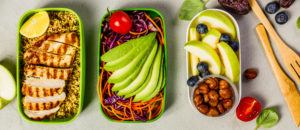By Iris Farrou
01 Nov, 2022
Diet & Exercise, Health Conditions and Pregnancy, Heart health, Lifestyle Tips, Mental Health, Nutrition, Pregnancy, Reproductive health, Women's Health
Anorexia and Pregnancy, Eating Disorders and Pregnancy, healthy eating, How to Eat While Pregnant, Hypertension, Mental Health Disorders During Pregnancy, Pregnancy Nutrition

The two most common types of eating disorders are anorexia nervosa and bulimia nervosa, yet there are other types out there that are not as common. Unfortunately, research on eating disorders and pregnancy is quite limited– there are estimations that eating disorders affect 5-8% of women during pregnancy, but this may not be completely credible as results can be skewed due to women’s reluctance to recognize eating disorders. Anorexia and bulimia often become noticeable in adolescence, and it’s possible that they linger during a woman’s reproductive years. Consequently, they can of course affect not only a woman’s reproductive health but also the health of her baby.
Fertility is the first affected area of women who suffer from an eating disorder: most women with anorexia do not have menstrual cycles, and approximately half of the women who have bulimia do not experience regular menstrual cycles. Absence of menstruation or irregular periods can limit the chances of conceiving, or even make it a lot more difficult for a couple to conceive. If you know you have an eating disorder and are seeking to get pregnant, it will be much healthier for you and your future baby if you try to treat your eating disorder first and establish some healthy eating habits. It is also important to share your history with medical professionals and ask for your weighing to be treated with more care.
Though there is quite a long list of complications associated with eating disorders during pregnancy, rest assured that proper planning and prenatal care– as well as a commitment to building healthy eating habits and helping your body remain healthy– can minimize a lot of those complications, lessen the risks associated with them, and enhance your chances for a healthy pregnancy. Some of those complications can be premature labor and low birth weight, as well as delayed fetal growth and respiratory problems. You may also be at a higher risk for emergency cesarean birth and other complications during labor. Gestational diabetes, preeclampsia, and even miscarriage are also possible complications. Women with eating disorders are also at a higher risk for postpartum depression, and depression during pregnancy, and are more likely to have problems with breastfeeding. Women with bulimia are at a higher risk for hypertension, and substances such as laxatives and other medications may be harmful to the development of the baby and can lead to fetal abnormalities as well.
Eating disorders unfortunately cannot be treated with medications that are pregnancy-safe. Treatment includes, first and foremost, the mother’s determination to have a healthy pregnancy and–difficult and shameful as it may be–disclosing to health professionals that you are struggling with an eating disorder. That way, your doctor will be able to tailor your prenatal visits accordingly, and know the risk factors associated with your pregnancy. The obstetrician’s care can be complemented by a registered dietitian/nutritionist and a therapist for well rounded care and medical treatment.
https://americanpregnancy.org/healthy-pregnancy/pregnancy-health-wellness/eating-disorders-and-pregnancy/
https://www.verywellmind.com/pregnancy-and-eating-disorders-4179037
More

The vast amount of online resources on healthy eating and living can be overwhelming. On average, women need between 1,600 and 2,400 calories per day. However, there is so much more involved than simply targeting a number. Healthy eating involves some basic principles for food selection.
- Whole foods: Choose whole ingredients over pre-made food, as processed foods contain added sugars. This means, opt for proteins, fruits, and veggies that are in their natural state. For example choose an apple over applesauce or apple juice. Consider adding honey and nuts to plain oatmeal instead of pre-packaged honey nut oatmeal. Remember, every choice adds up.
- Lean protein: Chicken, turkey, fish, eggs, beans, and tofu are great sources of protein with low calories. Avoid fattier meats such beef and bacon.
- Whole grains: Whenever possible choose brown rice over white rice and wheat bread over white bread. While white bread and rice may taste smoother, they lost many nutrients during the refining process.
In theory, this all sounds super easy. Of course, everyone knows chicken is healthier than beef, and we should all eat our veggies! However, so many people rely on packaged foods for convenience. Many women have families to also think about, so fast and convenient is important. Thus, we’ve put together a roundup of the best online resources to help you get started.
Meal prep: While it may sound like a ton of work, meal prepping doesn’t need to be an all-day affair. Check out 25 Healthy Meal Preps and Skinnytaste for numerous recipes to get started on meal prepping. Remember, even meal prepping just one meal per day (yogurt parfaits or overnight oats for breakfast, or hearty soup for lunch) will save you time and calories.
Time-saving dinners: Yes, it’s so very tempting to pick up Panera, Chipotle, or even Buffalo’s favorite, Mighty Taco, on your way home. It’s quick and your entire family will eat it. Eating out once a week isn’t too bad, but anymore than once and the calories will add up. Consider quick and healthy weeknight meals by opting for pre-cut proteins such as ground turkey and chicken breast tenderloins. Additionally, Buffalo-area grocery stores, such as Wegman’s and Dash’s, offer many options for pre-cut fruit and veggies. For fast dinner ideas, check out Cooking Light, Taste of Home, and Olive.
Helpful Apps: Even with making some changes in your diet with a focus on whole foods, lean protein, and whole grains, it may still be hard to find your ideal body weight. There are so many online resources and phone apps, but our favorites are MyFitnessPal and iTrackbites (similar to the Weight Watchers concept). Both are free (though you can update for a reasonable fee for a premium) and are easy to use. In addition, you can download the app to have quick access to log food on your phone.
More
 With the holidays right around the corner, it can be difficult to stay healthy and stick to fitness goals. The right mindset and practicing smart habits can make all the difference. It is indeed possible to survive the holiday season without your clothes getting too tight!
With the holidays right around the corner, it can be difficult to stay healthy and stick to fitness goals. The right mindset and practicing smart habits can make all the difference. It is indeed possible to survive the holiday season without your clothes getting too tight!
Establish Realistic Expectations: First of all, it is important to set attainable goals for yourself and to be honest about your expectations. It is perfectly normal to want to enjoy the sweet and savory treats that proliferate around holiday time. Think about how to achieve an appropriate healthy balance during this time. If weight loss is your goal, perhaps this is not the time to lose a significant amount of weight. Understanding that ahead of time will prevent you from feeling like a failure.
Indulge on Individual Occasions, not a Season: Avoid the “all-or-nothing” mindset that you are either 100% sticking to your healthy plan or “cheating” for the whole season. Allow yourself to indulge on certain days and keep to a routine on the other days. If you host a party, send leftovers home with your guests or bring them to work. Leaving treats in the house may cause these occasional indulgences to become staples.
Prepare Ahead of Time: With so many temptations at holiday parties, grocery stores, and even the breakroom at the office, it’s important to plan ahead. When preparing to run errands or go grocery shopping, eat a filling snack such as an apple or nuts to stave off hunger. This can also come in handy while baking, which can help control the temptation to graze on sweet ingredients. Having a snack or a small meal before holiday parties can help to avoid overeating.
Enjoy Smartly with Portion Control: Avoiding all of your favorite treats at holiday time will make you feel deprived and could lead to overeating. Choose some of your favorites and enjoy them in moderation. Try the “one plate” rule. Allow yourself one small plate of appetizers, one full plate of food for your main meal, and one dessert. Since alcohol is calorie dense and also lowers inhibitions, choose one drink to enjoy. Wine, wine spritzers, and light beer are better choices than mixed drinks with soda or fruit juice or sugary drinks like pina coladas and margaritas.
Work in Movement Creatively: It may be difficult to stick to your normal workout routine, so find other ways to incorporate extra movement. When holiday shopping, running errands, or even at work, park your car in the furthest part of the parking lot to get in some extra steps. Take the stairs instead of the elevator. Squeeze in activity any way that you can, such as taking walk breaks or doing exercises such as squats or jumping jacks.
Set Boundaries and Take Time for Yourself: The holidays can be a very stressful and busy time. Do not let your own needs become lost in the holiday haze. Take time to yourself every day, whether it is reading a book, listening to soothing music, taking a bath, etc. Don’t be afraid to say no to extra projects, activities, or requests for your time, energy, and attention. Create and stick to a budget, schedule, and eating plan that allow you to enjoy the holidays, while maintaining your sanity and health.
More



